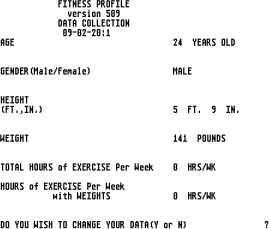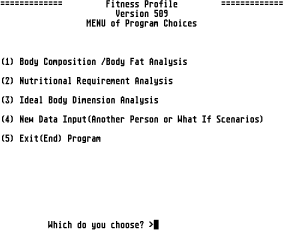Pump
it up!
Richard Dawid
explains how to get fit using an Atari
As a body
builder I have discovered the benefit of
eating healthily and taking regular exercise.
To discover how fit you are, here is a brief
guide to using my program, Fitness Profile.
Fitness Profile is a compilation of three
programs to analyze one's personal health
status in terms of body composition, energy
nutrient needs and ideal body dimensions.
Using
Fitness Profile
To run Fitness Profile, double
click on fitpr509.tos. The "Data
Collection" screen (below) will then
be displayed.

The "Data
Collection" screen asks for the following
information:
Field |
Action |
Age |
|
Input your age in
years (use whole numbers only) |
Gender |
|
Input [m] or [f] (case
is not important) |
Height |
|
Input your height
in feet and inches, separating
feet and inches with a comma.
For example, use 5,7 not 5 7.
If required, use decimals instead
of fractions with the inches.
For example, use (6,3.375) not
(5,8 3/8) |
Weight |
|
Input your weight
in pounds. If required, use
decimals not fractions |
Total hours of exercise
per week |
|
Input the estimated
total hours of all types of
exercise done each week averaged
over the last 6-month period.
This includes both aerobic and
anaerobic exercises that you
have done. Use whole numbers
only. |
Hours of exercise
per week with weights |
|
Input only the time
spent exercising anaerobically
with weights averaged over the
last 6-month period. |
After
inputting each field, hit [return] to enter
the data into the computer. If you have
made an input error, continue the requested
input on the screen.
Once the
last field has been completed, you must
confirm that the data on the screen is correct.
If correct, type [y] to output the data
to your printer and display the ”MENU of
Program Choices” screen. However, if the
data is incorrect, type [n] to display the
”MENU of Program Choices” screen and then
select number [4] to return to the "Data
Collection" screen.
Please note
that if the printer is off, no hard copy
will be printed. If you are using WinSTon,
you may get an error notice regardless of
whether the printer is on or off.
Once you
have reached the “Menu of Program Choices”
screen, you are ready to select an analysis
program. To select the program of your choice,
input the number and then hit [Return].

1) Body
Composition (body fat) Analysis
This menu choice
will perform body composition analysis.
The formulae have been calibrated to the
gold standard of analysis, hydrostatic weighing.
It also accounts for those who exercise.
The flaw with most methods, other than hydrostatic
weighing, is they account for only the average
population, not those at the extreme ends
of the curve. My formulae have taken into
account this factor.
Weight training
is defined as being intense anaerobic activity
with between 30 seconds to 2.5 minutes of
rest between sets of exercise, with a single
set of repetitions of the selected exercise
only being to be performed for a maximum
of 30 seconds.
Part of being
fit is to have a body fat level that falls
within an acceptably healthy range. Too
little body fat can be as detrimental as
too much. An acceptable range for females
would be between 10%-30%. A range of 10%-15%
is indicative of elite athletic status with
15% being considered ideal for most women.
The average American female has a body fat
level of 25%. For males, a range of 5%-10%
is regarded as the level for elite athletes
and 10% is considered to be the ideal body
fat percentage. The average body fat for
American males is 15%. An acceptable range
of body fat for men is 5%-20%.
BODY
FAT RATINGS |
Male
Fat %
(average=15%) |
Female
Fat %
(average=25%) |
0% -
4% |
UNHEALTHY |
0% -
9% |
5% -
10% |
EXCELLENT |
10% -
15% |
11% -
14% |
VERY GOOD |
16% -
19% |
15%
- 17% |
GOOD |
20% -
25% |
18% -
19% |
FAIR |
26% -
29% |
20% -
24% |
POOR |
30% -
34% |
25% &
up |
UNHEALTHY |
35% &
up |
Body
fat can be determined a number of different
ways. Each method has both its strengths
and weaknesses. The method to be used here
employs the use of girth or circumference
measurements. This method is very quick
and the least expensive. It also correlates
very favorably with the method of hydrostatic
weighing which is still considered to be
the most accurate and reliable method to
date by most authorities.
The newest
methods, electrical resistance and sound,
still have their problems and appear to
hold great promise in the very near future.
Caliper methods are the least reliable of
all the methods for a number of reasons.
Procedure
for determining body fat levels
To determine
your body fat level, you must use a good
cloth or plastic measuring tape and have
someone measure you at the appropriate 3
sites as you stand in the proper stance.
Having the proper stance when the measurements
are being taken is absolutely critical.
Small deviations can make a noticeable difference.
The three selected sites are determined
by your age and gender. The various sites
include:
- Forearm:
at the widest point
- Upper
arm: at the midpoint
- Waist:
at the narrowest point above the navel
Hips (buttocks): at the widest point
- Thigh:
where the thigh merges with the buttocks
- Calf:
at the widest point
While the
measurements are being taken, it is extremely
important that you stand properly; otherwise,
you jeopardize the accuracy of your body
fat determination. You should stand “at
attention” with 1 arm perpendicular to the
body and fingers “stretching out to the
wall”. Refer to the illustration for the
proper stance and measurement sites.

Do not
forcefully suck in your gut. Have someone place
the tape around the proper site, as listed
by the program. The tape should not squeeze
nor pinch the skin, but rather lie firmly
against it. The tape should be perpendicular
to the long axis of the body part. Have
someone take measurements and record each
to the nearest 0.125(1/8) inch.
Once the
measurement is taken, input the number and
then hit [Return]. The notation of that
site and the value being used in the calculation
next appear. Underneath this screen output
is the second site to be measured. Continue
inputting values as requested till all three
sites have been entered. The interpolation
adjustments of the formula are shown.
Underneath
the interpolation values are body fat estimates
showing: the uninterpolated body fat, the
next lower body fat level, if possible,
should you increase the amount of exercise
performed, and the interpolated body fat
estimate at your current level of exercise
intensity and duration averaged over the
last six months. Also calculated is your
lean (fat-free) body mass in pounds. The
last item is a statement indicating if additional
exercise will be of any value to further
lower your body fat level.
To return
to the “MENU of Program Choices” screen,
input of any number “from 1 to 9”, followed
by [Return].
2) Nutritional
Requirement Analysis
The Nutritional
Requirement Analysis examines only the energy
nutrients, which are carbohydrates, fats
and proteins. This choice (2) asks for your
activity level. If you are unsure or don't
know, hit [y] to get a description of the
activity levels presented. Upon hitting
[y], you are asked to select from one of
four levels to view. Pick the one you feel
might be closest to you by hitting a key
from [1] to [4].
A screen
will appear describing the selected activity
level. The cue at the bottom of the screen
tells you to hit [0] sending you back to
the previous screen. To return back to the
nutrition analysis, once you have determined
the activity level that best describes you,
hit [5] and follow the prompt. The next
screen asks you to input the number (1 to
4), which is closest to being your activity
level for that day.
Your chosen
activity level appears near the bottom of
the screen as verification of the correct
selection. Follow the screen prompt to get
to the screen with the nutrient requirements
for your body based on that day's activity
level. Hit [0] to return to the “MENU of
Program Choices” screen.
3) Ideal
Body Dimension Analysis
The last analysis option
is ideal body dimensions. For males, this
will give you the Greek or Roman ideal,
not the television version of those on anabolic
drugs. For females, there are not really
any good formulae because of the wide variety
of shapes that we find with female physiques.
These formulae
appear to be more in line with clothes designer
measurements for females with a healthy
body fat level. To determine your ideal
dimensions, simply input the requested data.
Once that is done, the measurements are
displayed along with your ideal weight for
your body frame. Refer to the diagram for
the proper stance and measurement sites.

4) New
Data Input (Another Person or What if Scenario)
This menu item
is self-explanatory. It allows you to get
back to the “Data Collection” screen to
do another analysis of either another person
or “what if I….”. For example, input double
your present weight and input the same data
for the rest of the requested information.
Now compare how many calories you would
need to sustain your new weight. It might
shock you to see the outcome!
5) Exit
(End) Program
Hit number “5” and follow the
prompts to exit the program. |
![]()
![]()
![]()